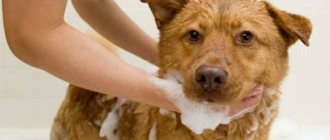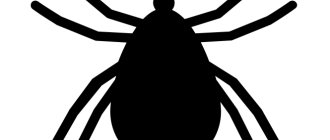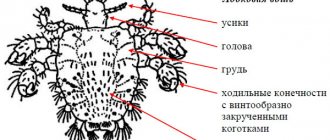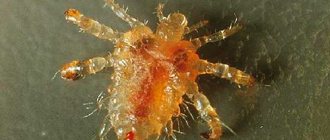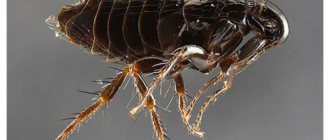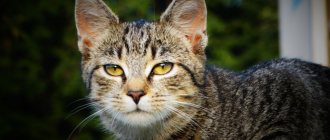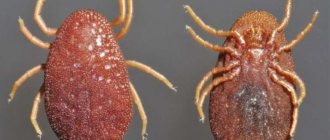External characteristics of fleas in cats
Most often, when an owner notices blood-sucking parasites on his cat, we are talking about the cat flea, or Ctenocephalides felis.
Despite its name, this type of parasite lives not only on cats, but also on rats and dogs. They can also feed on human blood. In addition to the cat flea, other types of fleas can be found on furry purrs:
- dog;
- rat;
- human;
- rabbit
Their external differences can only be detected under a microscope. Therefore, an ordinary person will not be able to determine with the naked eye which fleas have chosen a pet.
Cat fleas are very small, smooth and look like shiny grain. If they didn't move, it would be very difficult to notice them.
The cat flea can parasitize other animals and also feed on human blood.
A typical cat parasite is approximately 2–3 mm long. The body structure of a flea provides it with the following characteristics:
- The cat flea does not have wings, making it difficult to catch and contain.
- Parasites have a flat body. This ensures ease of movement between the hairs of the victim.
- Elongated hind legs help make large jumps.
- All parasites that attack a cat are dark brown or black in color.
Fleas cause a lot of trouble for both animals and humans.
How to tell if a cat has fleas
Fleas can be detected on an animal’s body based on several signs:
- the cat is acting restless;
- small wounds may appear on the body;
- if you put a cat on a clean sheet of paper and start combing it, tiny black grains will begin to fall out of the fur, which turn blood red when in contact with water;
- Small insects run around the animal's body.
To see flea feces, you need to place the cat on a white towel or paper and start combing it.
The favorite places for fleas on an animal are the chest, back and stomach. And due to the fact that they reproduce at an extremely high rate, their appearance is possible on other parts of the body.
Are fleas dangerous for humans?
Fleas can cause discomfort not only to pets, but also to humans. At times, parasites bother people by biting them, and any fears about this are not unfounded. After the bites of these parasites, unpleasant consequences can be observed on the skin in the form of blisters and papules. In addition, fleas can cause a skin infection in humans, which manifests itself in the form of ulcers or abscesses.
A person can become infected with helminthiasis by accidentally getting cat fleas into their mouth. The disease is asymptomatic in most cases.
Are cat fleas transmitted to humans? This depends on the gender and age of the pet. For example, a kitten's fleas are more likely to be transmitted to humans and begin to bite both the animal and its owner. Fleas are transmitted from cats to humans more often than from cats.
Prevention of fleas in kittens of different ages
The best treatment for fleas in a kitten is to prevent their occurrence. Of course, first of all you need to take care of eliminating fleas in the apartment. To do this, the home must be vacuumed daily.
It is important to pay attention to the places where the cat appears most often. It has been noticed that up to 50% of all fleas in the house can be destroyed by this simple hygiene procedure. It is important to protect the kitten from communication with homeless and stray animals
It is important to protect the kitten from communicating with homeless and stray animals. At least once a week you will have to treat the kitten’s sleeping place
The litter can be vacuumed or washed. Don't forget about car and cat carrier treatment
At least once a week you will have to treat the kitten’s sleeping place. The litter can be vacuumed or washed. Don't forget about treating your car and cat carrier.
At the same time, it is necessary to carry out preventive treatment of the animal itself. You can put a collar on it (if age allows) and carefully examine your pet’s skin.
Important: if there is a noticeable deterioration in the kitten’s well-being, you should immediately seek help from a veterinarian. Timely prevention of fleas is the key to a kitten’s activity and curiosity.
Timely prevention of fleas is the key to a kitten’s activity and curiosity.
Little kittens need love and constant care from their owner. It will not be possible to raise a beautiful, devoted and at the same time independent person from a defenseless fluffy ball without effort. Flea control is just one of the problems encountered when caring for a kitten. But your efforts will be rewarded with happy purring and love from your pet.
Galina Shishkina
Pensioner. I live in a village. I love animals, walks in the forest and tinkering in the garden. Cat owners often face the problem of fleas in their pets. These parasites cause a lot of trouble for pets, causing them itching, which occurs after bites. Even a newborn kitten does not escape this fate. Hoping to get rid of insects, small creatures scratch themselves, resulting in scratches and abrasions on their bodies. It is not uncommon for kittens to be allergic to fleas. In addition, cat fleas pose a danger to humans. All this suggests that it is necessary to rid your pet of them. Therefore, the question of how to remove fleas from small kittens interests many owners of these cute creatures.
Signs and routes of infection
Understanding whether a cat or newborn kittens have fleas is not a tricky matter; the main thing is to pay attention to a number of signs in time:
- itching;
- the appearance of wounds and scratches on the body;
- nervous behavior;
- traces of flea activity on the animal’s body;
- hair loss;
- baldness.
Fleas are jumping, hardy insects that can live without food, waiting for a new owner, for up to 18 months. And if a blood-sucking insect is hiding in the grass, then a cat passing by will undoubtedly be infected. Even if the pet has not been outside, insect eggs and larvae can be carried on the shoes or clothes of household members.
Flea
One flea on a cat's body is enough to create a population of blood-sucking fleas within two weeks. The parasite does not lay eggs in one place, but sprays them in different places, so they can end up on bedding, furniture, and the floor.
And you shouldn’t be surprised if a pregnant cat, which never leaves the apartment, or newborn kittens suddenly develop fleas.
How to remove fleas from a cat using folk remedies
To rid your pet of biting insects using folk remedies at home, two conditions must be met: a systematic approach and a careful choice of remedy. Only with constant treatment of wool will it be possible to remove parasites and prevent their return
You should pay attention to the components included in the product, some of them may be more toxic than the insecticide
In addition to caring for the cat, it is necessary to treat all cat objects: house, bedding, toys, rug, since they can contain both adults and their offspring. If you ignore this point, you will not be able to remove fleas completely. If there are several cats living in the house, treatment should be carried out simultaneously on all pets, even if only one of them is infected. Treatment with folk remedies demonstrates a high effect with little infection and is used in the following cases:
- cat pregnancy;
- allergic reactions of animals to components of insecticidal agents;
- illness of the animal and the use of traditional household remedies can aggravate the disease;
- presence of a kitten in the house.
Approximate cost of anti-flea accessories
The cost of collars varies depending on the manufacturer. Imported analogues are priced at 500-800 rubles, depending on the duration of action. There are copies priced at 3,000 rubles.
Russian analogues are priced from 50 to 250 rubles, depending on the composition and duration of action.
It is not recommended to use cheap Chinese analogues. The active substances included in their composition have not been studied. This can negatively affect your pet's health.
Review of flea products
Veterinary pharmacies have a large assortment of effective drugs that allow you to remove all kinds of parasites that bother animals. However, many owners of furry creatures are concerned about the question of how to remove fleas from a pregnant cat at home. After all, for such animals it is necessary to select special means that cannot harm either the expectant mother or her offspring. Therefore, ridding the cat of bloodsuckers before the birth of kittens is the main task of every owner of a furry pet. To treat and prevent infection with ectoparasites for pregnant cats, you can use the most gentle and low-toxic means:
It is advisable to discuss the choice of the preferred protective and therapeutic drug or accessory with your veterinarian.
Antiparasitic collars
A special plastic tape impregnated with an insecticidal composition is the most popular and simple means of ridding and protecting an animal from ectoparasites. Many owners are trying to find out whether a pregnant cat can wear a flea collar during the entire period of gestation.
Veterinarians emphasize that in each individual case the question of using a particular drug or flea accessory is decided after examining the animal
Despite this, experts believe that the devices are a safe and effective means of ridding an animal of parasites. This is explained by the fact that medications will not get into the bloodstream or onto the skin of your pet. The most gentle flea treatment for pregnant cats is a biological collar soaked in essential oils that repel bloodsuckers. The most famous representatives of this product line are the Celandine, Doctor Zoo and BioBand straps from the Beaphar, Bars brand. Products marked “bio” contain oils of cinnamon, cloves, bergamot, cedar, lavender and other fragrant plants. Absorbed into the skin and fur, the fragrant composition repels parasites. Despite the complete safety of the impregnation components, you should remember that you should only put a flea collar on a pregnant cat after consulting a doctor.
We were very worried about our cat when they discovered fleas. On the advice of the doctor, I had to put a Celandine bio-collar on her. It’s good that we noticed the insects on time, because after a short period of time there were no parasites on Murka.
Anti-flea shampoos
Specialized pharmacies offer a wide range of insecticidal shampoos that allow you to effectively and safely remove bloodsuckers from your four-legged pets. Detergents are harmless to animals, but dangerous to parasites, as they do not leave them a chance to survive. It is recommended to wash a pregnant cat with flea shampoo only if she is accustomed to bathing and it will not cause her stress.
We saved our pregnant cat from fleas with Lugovoi shampoo. It is safe and contains herbal ingredients. The doctor recommended it. We started bathing our pet a long time ago, so she is not afraid of these procedures. There are no fleas, and future kittens can be safely fed to their mother, without fear that the babies will become infected.
Drop medications
Flea drops for pregnant cats are recommended by a veterinarian after examining her. Poisoning ectoparasites in this way is quite simple - you need to drip medications onto the withers or along the spine of the animal. The best drugs are those that do not penetrate the pet’s blood, act gently and contain low-toxic insecticides in their composition. For animals expecting offspring, veterinarians recommend the safe drugs Frontline, Advantage and Stronghold. They are well tolerated by cats, do not harm kittens and even protect them from parasite infection. It is necessary to apply flea drops onto dry skin, strictly following the instructions. During the procedure, it is recommended to wear gloves to avoid contact with the drug.
Frontline solution saved our cat from fleas. I had to treat it on the advice of a doctor. I recommend it to everyone - simple and safe.
Knowing how and with what to remove dangerous ectoparasites, you can cure a pregnant cat without harming its health.
Types of collars
There is no fundamental difference between flea collars for cats and dogs from different manufacturers in appearance and principle of operation. However, in any case, you should choose a collar for your pet that matches its type, size and age.
Flea collars for cats
Well-known brands of cat insecticidal collars:
- Hartz is a popular American product, can be used even in wet form, the content of the toxic substance depends on the weight of the pet, the active ingredient - tetrachlorvinphos - begins to act in 5-7 days, the period of use is 7 months, it is contraindicated for kittens under three months old, pregnant and lactating cats, sick animals;
- Bolfo is a waterproof collar made in Germany, selected depending on the animal’s body weight, the active component - propoxur - begins to act after a few hours, it is recommended to wear it 24 hours before walks, period of use - 4 months, suitable for kittens from three months, pregnant and lactating cats after consultation with a specialist, but not recommended for sick and weakened animals;
- "Bars" is a Russian product that cannot be wetted, is cheaper than foreign competitors, but is not inferior to them in effectiveness, contains diflubenzuron, begins to act in about a day, shelf life - 4 months, is not recommended for pregnant females in the last trimester, lactating cats and kittens younger two months;
- Beaphar - made in Holland, there are two types: Ungezieferband based on the active ingredient diazinon - effective 5 days after putting on, suitable for cats from 6 months, waterproof, works for six months, not suitable for sick, weakened, pregnant and lactating pets;
- SOS Flea and Tick Collar based on the substance tetrachlorvinphos - valid for 8 months, not afraid of moisture, there are options for kittens from six weeks of age, contraindications - sick and weakened animals;
Photo gallery: types of flea collars for cats
Hartz contains a strong toxic substance, so it is important to be careful when using it
Bolfo has a very intense scent
Bars is a domestic analogue of foreign funds, but no less effective
Beaphar produces collars with different compositions, including bio-collars
Allergies may occur when wearing the Doctor Zoo collar.
Flea collars for dogs
Manufacturers of insecticidal products for dogs:
- Kiltix is a German brand that produces water-resistant collars for dogs of different sizes, the active components of the products are flumethrin and propoxur, their effect appears after 24 hours, the validity period is up to 7 months, they are not suitable for sick animals, pregnant and lactating animals, as well as puppies up to two months;
- Skalibor is a French representative, the collar contains deltamethrin, is effective a week after the start of use, is waterproof, can be used for 6 months, is suitable for puppies from two months, sick, pregnant and lactating dogs;
- Hartz - products of this brand are similar in composition and properties to cat collars; they are contraindicated for puppies under six weeks of age, pregnant and lactating dogs, and sick animals;
- Beaphar - dog collars are similar in composition, properties, use, and contraindications to cat collars from this manufacturer;
- Rolf Club is a Russian manufacturer of collars based on fipronil and pyriproxyfen, the products are not afraid of moisture, are active for up to 4 months, they can be used by puppies from three months, pregnant and lactating dogs only after consultation with a veterinarian, and they are contraindicated for sick and weakened animals.
When choosing the right collar for your pet, consider a combination of effectiveness, safety, and price.
Photo gallery: types of flea collars for dogs
Kiltix - an effective flea and tick collar, but not a cheap one
Scalibor is odorless and, in addition to fleas and ticks, also protects against mosquitoes
Hartz is an expensive collar, has a toxic composition, a pungent odor at first, but is very effective against fleas
Beaphar SOS Flea and Tick Collar contains a more toxic substance in its composition, unlike other types of collars of this class=”aligncenter” width=”514″ height=”577″[/img] Rolf Club is an odorless collar when used correctly does its job well
Biocollars
For those who do not like to use chemicals either for themselves or for their pets, there are special biocollars impregnated with natural ingredients. The active ingredient in such products is essential oil.
In addition to the natural composition, the main difference lies in the action - the smell, spreading through the fur, only repels, but does not kill existing individuals and their larvae. Therefore, such collars can be used either before infection, as a preventive measure, or after flea treatment with other means. The validity period is 2–3 months.
The advantage is that the collars are non-toxic and safe for animals and humans. But essential oils can cause allergic reactions, especially in cats, who react very strongly to scents. Therefore, it is necessary to monitor your pet’s reaction upon first use.
The following types of biocollars are known:
- Beaphar BIO BAND - the collar is available for both dogs and cats, contains natural margosa oil, which also has an antifungal and antiviral effect, suitable for babies from two months, valid for up to 4 months;
- ProVET STOP bio - also available for both dogs and cats, includes a complex of oils of wormwood, mint, cloves, margosa, has a positive effect on the skin and coat, suitable for young, old and sick animals, valid for 3 months;
- Trixie bio - for dogs and cats, contains margosa and lavender extract, effective for two months, suitable for animals older than three months.
The active component of the Beaphar BIO BAND flea collar is margosa oil
Ultrasonic collars
An alternative to insecticidal and biocollars is ultrasonic, which emits waves whose frequency is perceived only by insects. This collar is a fabric or leather tape with a battery-powered ultrasonic device. Under its influence, the fleas' nervous system is irritated, they stop reproducing and leave the animal's body.
The product is suitable for pets who are allergic to natural essential oils or cannot tolerate toxic chemicals. But animals are able to detect high-frequency vibrations, and constant wearing of such collars can harm them. Therefore, before use, you must consult a veterinarian, carefully follow the instructions and monitor the behavior of your furry friends.
The frequency emitted by ultrasonic collars can sometimes be detected by animals
Homemade flea collars
A variety of flea collars allows you to choose one suitable for any size, age and budget. However, with the quality of an anti-flea accessory, as a rule, the price also increases, and a decrease in toxicity will shorten the lifespan (biological collars lose their properties faster than chemical ones). A self-made collar will allow you to save money, but at the same time maintain its safe and effective properties. The components of such a homemade device can be found in pharmacies and at home:
- a fabric collar or strip of any natural fabric 10 cm longer than the pet’s neck;
- witch hazel extract, essential oils of lavender, cedar, thyme;
- garlic oil.
Garlic oil is an essential component of homemade flea collars
. Manufacturing instructions:
- Mix 3 tablespoons each of witch hazel and garlic oil.
- Add 6 drops of aromatic oils.
- Soak the prepared strip of fabric in the resulting solution for 5–10 minutes.
- Let the collar dry for 1-2 days.
After a month of use, the homemade collar must be replaced with a new one. This composition is too odorous for cats, so it can be replaced with an alcoholic infusion of rosemary or lavender. In any case, when using this or any other anti-flea collar, it is necessary to monitor the condition of the patient, and, if necessary, replace the product used with another.
A DIY collar is a good alternative to expensive store-bought products.
What is the danger of parasitic insects?
No one is protected from fleas. For an innumerable number of these parasites to appear in your apartment, it is enough to bring in one such bloodsucker. At the same time, it is not at all necessary that the pet come into contact with a flea-bearing animal. A flea can “arrive” on your shoes or on the paws of any pet.
Fleas carry a large number of diseases that pose a threat to both cats and people. We can highlight the main and most common health problems that can arise from these insects:
- Allergic reactions. Some cats are allergic to flea saliva. In this case, the animal will itch even more. And if the allergen is not eliminated in time, then such proximity in some cases leads to hair loss and the formation of scabs on the cat’s body.
- Worms. Fleas carry the eggs of parasites such as pinworms, roundworms, and flukes. While licking its fur, the cat swallows a considerable number of these eggs. And in kittens and weakened animals, helminthic infestation in some cases leads to death.
- Anemia. In advanced situations, long-term coexistence of an animal with fleas leads to anemia in the pet (decreased hemoglobin in the blood).
Human contact with fleas is dangerous because these insects can be carriers of serious diseases. One bite of such parasites can infect a person:
- worms;
- salmonellosis (acute intestinal infection of animals and humans caused by salmonella);
- encephalitis (an inflammatory process affecting the brain);
- typhoid (an infectious disease accompanied by mental disorders against the background of severe fever and intoxication);
- tularemia (an acute infection that affects the lymph nodes, skin, lungs, and sometimes the mucous membranes of the eyes and pharynx);
- brucellosis (a dangerous infection that affects all systems of the body).
One flea bite can lead to many diseases
Contraindications and negative consequences of use
Most flea collars have contraindications for use:
- Do not use on sick or weakened animals;
- do not combine with other insecticidal preparations;
- Take precautions when coming into contact with the collar.
When choosing an accessory for kittens, pregnant and lactating pets, you must choose special options marked “approved for use” or seek help from a veterinarian. When handling the collar, you must follow the instructions, as human skin is more sensitive to toxins than animal fur. It is important to avoid getting the product on the mucous membranes of the eyes, and ensure that children or other pets do not touch the collar. After contact with the product, you must wash your hands with soap.
Allergic reactions
The chemical composition with which the collar is treated can in some cases cause an allergic reaction. It all depends on the individual characteristics of the animal’s body. Therefore, when using the product for the first time, it is necessary to monitor the condition of the cat or dog. Symptoms of an allergic reaction:
- irritation on the skin;
- salivation;
- lacrimation;
- hair loss;
- sneezing;
- restless behavior.
If they appear, you must immediately stop using the collar and seek advice from a veterinarian.
The smell from the collar
Typically, the main disadvantage of flea collars is the unpleasant odor. However, among modern antiparasitic devices there are products with a pleasant smell or without it at all. Biocollars usually have a light, pleasant aroma of essential oils. A pungent odor should usually dissipate over time. If this does not happen and it causes discomfort to you and your pet, then it is better to choose a less odorous option.
Poisoning an animal with toxins
Regardless of the cost or quality of the collar, it can cause poisoning to your pet if a cat or dog suddenly licks, bites or chews it. First of all, it is necessary to identify the symptoms of poisoning:
- lethargy of the pet;
- refusal of food, thirst;
- increased salivation;
- diarrhea, nausea, vomiting;
- heavy breathing, dilated pupils.
Refusal to eat and severe thirst are one of the signs of animal poisoning.
In such cases, urgent consultation with a veterinarian is important. If possible, you should find instructions for the collar you are using: manufacturers indicate information about the antidote. This information will also help the veterinarian select the appropriate medication, since different collars contain different active ingredients in their composition.
You can provide first aid on your own, eliminating further ingress of toxins - remove the collar and wash off its residue from the fur. Cleaning the stomach with any medications for humans will also help: activated carbon dissolved in water (1 tablet per 1 kg) or other absorbent.
Review of flea products
Flea remedies
Veterinary pharmacies have a large assortment of effective drugs that allow you to remove all kinds of parasites that bother animals. However, many owners of furry creatures are concerned about the question of how to remove fleas from a pregnant cat at home. After all, for such animals it is necessary to select special means that cannot harm either the expectant mother or her offspring. Therefore, ridding the cat of bloodsuckers before the birth of kittens is the main task of every owner of a furry pet. To treat and prevent infection with ectoparasites for pregnant cats, you can use the most gentle and low-toxic means:
- flea collars;
- special disinfectant shampoos for cats;
- flea drops
It is advisable to discuss the choice of the preferred protective and therapeutic drug or accessory with your veterinarian.
Antiparasitic collars
A special plastic tape impregnated with an insecticidal composition is the most popular and simple means of ridding and protecting an animal from ectoparasites. Many owners are trying to find out whether a pregnant cat can wear a flea collar during the entire period of gestation.
Veterinarians emphasize that in each individual case the question of using a particular drug or flea accessory is decided after examining the animal
Flea collars
Despite this, experts believe that the devices are a safe and effective means of ridding an animal of parasites. This is explained by the fact that medications will not get into the bloodstream or onto the skin of your pet. The most gentle flea treatment for pregnant cats is a biological collar soaked in essential oils that repel bloodsuckers. The most famous representatives of this product line are the Celandine, Doctor Zoo and BioBand straps from the Beaphar, Bars brand. Products marked “bio” contain oils of cinnamon, cloves, bergamot, cedar, lavender and other fragrant plants. Absorbed into the skin and fur, the fragrant composition repels parasites. Despite the complete safety of the impregnation components, you should remember that you should only put a flea collar on a pregnant cat after consulting a doctor.
Anti-flea shampoos
Specialized pharmacies offer a wide range of insecticidal shampoos that allow you to effectively and safely remove bloodsuckers from your four-legged pets. Detergents are harmless to animals, but dangerous to parasites, as they do not leave them a chance to survive. It is recommended to wash a pregnant cat with flea shampoo only if she is accustomed to bathing and it will not cause her stress.
Lugovoi flea shampoo
Drop medications
Flea drops for pregnant cats are recommended by a veterinarian after examining her. Poisoning ectoparasites in this way is quite simple - you need to drip medications onto the withers or along the spine of the animal. The best drugs are those that do not penetrate the pet’s blood, act gently and contain low-toxic insecticides in their composition. For animals expecting offspring, veterinarians recommend the safe drugs Frontline, Advantage and Stronghold. They are well tolerated by cats, do not harm kittens and even protect them from parasite infection. It is necessary to apply flea drops onto dry skin, strictly following the instructions. During the procedure, it is recommended to wear gloves to avoid contact with the drug.
Knowing how and with what to remove dangerous ectoparasites, you can cure a pregnant cat without harming its health.
Does it help?
When pet owners are interested in whether flea collars help cats and whether it makes sense to purchase one, they need to become familiar with the strengths of such devices.
They are as follows:
- there is no need to simultaneously carry out special hygiene procedures (use sprays or shampoos, as well as combing);
- a cat wearing such an accessory will not bring parasites after walking outside, and drops or other means do not provide such a guarantee;
- such an accessory is universal and can repel fleas, lice, ticks or reduce their activity;
- special products are suitable for use by pregnant cats or kittens;
- the protection period is quite long (up to 6 months);
- wide range of protective products;
- various price categories;
- minimal risk of overdose of toxic substances;
- An animal walking on the street is immediately positioned as a pet with such an accessory.
The effectiveness of the collar against fleas can be observed after 2-3 days from the start of its use. When choosing a means of protection against bloodsucking for their pet, owners should take into account various factors: age, temperament and the general health of their pet. If this is possible, you should first consult a veterinarian, who will inform you in detail about how flea collars work.
Treatment of mother cat for fleas
Any antiparasitic treatment of an animal is a burden on the body. Newborn kittens are extremely sensitive to any veterinary flea medications, and most chemicals are prohibited for use until the babies reach a certain age. Failure to comply with this rule can lead to poisoning not only of the babies themselves, but also of their mother. The cat constantly licks its offspring; therefore, everything that is applied to the babies’ fur will end up in its digestive tract, blood and milk. However, you cannot delay treatment, since anemia caused by fleas can claim the lives of all kittens in a matter of days.
The degree of flea infestation can be reduced by treating the cat with veterinary drugs approved for use in lactating animals. Even if a certain number of insects survive, they will not cause much harm to normally developing kittens.
Veterinary drugs approved for use in nursing cats:
- Drops on the withers Advantage (Advantage) 40. A reliable and safe insecticide for external use, which has an “umbrella effect” (when treating a nursing cat, the litter also receives protection). The main active ingredient is imidacloprid. The drug does not affect the central nervous system of mammals. Apply directly to the skin, in a place that the cat cannot lick (between the shoulder blades).
- Frontline Combo drops for cats. A fast-acting remedy with a long-lasting effect. The active ingredients are fipronil and S-methoprene. The drug is safe to use in pregnant and lactating females. Apply to the withers.
- Drops against fleas and ticks Beaphar (Beafar). Natural parasite repellent. The active ingredient is an extract from the Neem (Margosa) tree. Safe drug without side effects.
A nursing cat can be bathed with anti-flea shampoo, but the spray should be used with extreme caution during lactation. Immediately after hair treatment, the cat should not be allowed to lick itself, as some of the toxic substances may enter the digestive tract and milk.
Wearing rules
Many collars emit a specific unpleasant odor, so cats do not like wearing them around their necks. Basic tips for the correct use of collars:
- open the package;
- put the collar on in such a position that your fingers can be easily held between it and the animal’s neck;
- secure it with a special fastener;
- trim the excess length of the tape.
The instructions on the package or from the manufacturer indicate a maximum shelf life ranging from a few weeks to six months. It is best to replace it at least once every 2-3 months.
Important! The period of protection against fleas is 4 - 6 months, against ticks is much shorter - no more than 2 months.
Remedies for getting rid of parasites
The industry produces many effective products that help remove fleas.
Small kittens are very sensitive to various chemicals; treating kittens with flea products should be done carefully and carefully. Their body is not yet ready to take pharmaceuticals, due to the fact that poisoning can occur, not only for them, but also for their mother, since she constantly licks them
The product gets onto the wool, and with it into the milk. Let's look at how to get rid of fleas on a kitten using different types of products:
- Combing with a comb. This method is quite labor-intensive, but if there are one or two kittens in the house, you can use it. You can see what fleas look like on kittens in the photographs in the article. The animal is placed on one's lap, having previously laid down a white diaper or sheet, and is combed with a thick comb in the direction of the baby's fur. You can comb out fleas so easily; they are clearly visible on white fabric. You can't leave them. First, they should be crushed and then placed in a container of water. This method is suitable if the kitten is 2 weeks old or a little more.Getting rid of fleasNote! Insecticides can only be used after the kittens are weaned from the mother's breast. The instructions for any drug contain the required dosage and indication for use. It should be strictly followed.
- Shampoo. Shampoos for kittens are sold in specialized stores. With their help it is easy to get rid of insects. First, apply the shampoo to the entire surface, wait a few minutes, then rinse thoroughly with water. How to use it correctly is written on the tube or bottle. All conditions must be strictly observed. The most popular shampoos are: Lugovoi, Bars, Ms Kiss, Celandine.
- Drops. They are also suitable for removing fleas at home. After making sure that this is a suitable remedy, you need to drip it onto places that cannot be crawled out. The most common place is the area of the withers and shoulder blades. The fleas should die within 24 hours. To consolidate the result, it is recommended to use shampoo after applying the flea drops, remembering to wash the animal’s fur well upon completion of the procedure. The following drops are considered the best: Advantage, Dana Ultra Neo, Frontline. Review
My cat lives in an apartment, so he doesn’t go outside. But the neighbors have a dog, and as a result, my pet picked up fleas from him. I used drops and shampoo to remove it, they helped perfectly.Olga, Kazan
- Flea spray. This is a fairly effective product called Frontline, it is sold in the form of a spray and drops. Spray all over the kitten's fur. The instructions say at what distance this should be done. Many people are interested in the question of how to treat their face so that the spray does not get on the mucous membrane. Cotton swabs are used for this purpose. It is imperative that the drug also gets on the skin, otherwise it will not be possible to remove fleas. Spray and flea collar
- Collar. Some owners believe that this is the best remedy for fleas. It puts on quickly without causing any hassle. This opinion is wrong. It should be put on only after treatment has been completed. The collar is used for preventive purposes; it can protect the kitten from re-infection.
- Mixtures. Special medications are available for sale in veterinary pharmacies. Based on them, solutions are prepared that help get rid of insects. You can treat the fur and body of a small animal using cotton pads. You need to make sure that the baby does not lick off the applied product until it dries. There is no need to wash the kitten after this.
If you are unable to remove fleas on your own, the best way is to contact a veterinarian.
Drops
Drops can be used for treatment after a veterinarian's prescription, because some of them enter the bloodstream
Pay attention to the composition: it should be as gentle and low-toxic as possible. Here is a list of what drops can be used to treat fleas on a nursing cat:
Inspector. A low-toxic but effective drug, it is harmless, therefore it is allowed to be used when it is necessary to poison fleas on a pregnant or lactating cat over 4 kg. The dosage is prescribed in the instructions; apply drops to the skin of the animal, spreading the fur at the withers. Kills fleas and helminths, the result lasts for two months. In the room you need to treat the rug, bed, upholstered furniture, carpets, otherwise the parasites will again annoy the animal. Carry out daily wet cleaning. Advantage, after application, quickly covers the skin with an invisible protective layer. Highly effective, does not enter the bloodstream, therefore safe for pregnant and lactating animals. The fleas die completely after twelve hours. The product should be dripped onto the withers without rubbing. Moisture-resistant, do not wash off even when the cat is exposed to rain or snow. The results will last for two months and apply to kittens.
When applying, it is important to observe safety precautions, make sure that the animal does not lick the drug; for this you can wear a collar.
Advantage drops
Frontline. After repeated laboratory studies, it was classified as one of the safest products intended for eliminating parasites on cats during pregnancy and nursing kittens. Please read the instructions carefully before use. Frontline is sold in a soft ampoule. After opening, you need to spread the fur on the withers, it is important that the pet subsequently cannot reach this place with its tongue, apply the required amount to the withers and between the shoulder blades. It is evenly distributed over the skin of the animal throughout the day, leading to the death of insects. The effect lasts for two months. Stronghold is an effective remedy that helps kill fleas. Does not cause adverse reactions and is well tolerated by pregnant animals. Apply to the withers, dry quickly, there are no oils in the composition, so it does not stain the coat. Valid for a month.
Other drops also worked well:
If fleas appear on a nursing cat or kittens, do not panic. The choice of anti-flea drops in veterinary pharmacies today is small, but compared to other drugs they act quickly, are well tolerated by kittens, and do not cause allergies. Protects against the appearance of new parasites for up to two months. This time will be enough for the kittens to get stronger, grow up and find loving homes.
The appearance of fleas in an animal brings discomfort not only to the pet, but also to its owner. Parasites spread diseases, multiply quickly and are capable of laying large numbers of eggs in a short period of time. They bite people, causing severe allergic reactions and inflammation of the skin. And the sooner measures are taken to destroy them, the less chance there is of developing concomitant infections.
Currently, veterinary clinics have quite effective insecticides that, if used regularly and correctly, will not only remove blood-sucking parasites, but also prevent re-infection. Traditional medicine also has methods that can help you get rid of insects at home and prevent their further reproduction.
How does it work?
Let's look at the operating principle of the most popular collars for pets - bio- and insecticidal.
Both insect repellents work in a similar way. When attached to the pet’s neck, the active substance with which the strap is impregnated begins to be evenly distributed throughout the animal’s fur. Thanks to a special formula and technology, the essential oil or insecticide is released in portions. This allows you to maintain an ideal balance of the concentration of the active substance without harming the pet’s health.
After attaching this device to the pet’s neck, the active substance spreads throughout the fur and begins its action.
The essential oil (insecticide) is selected in such a way that it has the most negative effect on parasites, while causing minimal harm to the cat (dog).
Essential oils will not cause any harm to your pet, but will be harmful to parasites.
After you fasten the strap around your pet’s neck, after one hour the impregnation will be evenly distributed over the surface of the fur, starting to cause a lot of trouble for the parasites.
These collars very rarely cause side effects.
Symptoms of cat fleas
If there are too many fleas, then it will not be difficult to detect them with the naked eye - they will run around the kitten’s belly, behind its ears and armpits. If fleas have not had time to breed, they are difficult to detect and the following symptoms will indicate their presence:
- The kitten is acting restless;
- Due to the itching from bites, the pet constantly itches with its paw behind the ear and can gnaw fleas out of its fur;
- Bites are visible in the form of red spots and wounds;
- In the kitten's frequent habitat and on its fur, flea excrement can be found in the form of small black dots less than a millimeter in diameter;
- In the presence of parasites, dermatitis and allergies may occur;
- Weight loss.
IMPORTANT: When fleas are detected, you should not run to the veterinary pharmacy and buy the first remedy you come across. It is necessary to select a method for destroying parasites based on the age of the kittens and the danger of the product for babies.
How to remove fleas from domestic kittens at home?
It is necessary to destroy fleas quickly and effectively, as they are carriers of dangerous diseases. Also, kittens may die due to the very large number of multiplying parasites. Below are different options for controlling parasites based on the age of the kittens.
In newborns and up to 2 months
Newborn kittens are very vulnerable to both fleas and anti-flea chemicals.
Therefore, you need to choose the most gentle method. But before starting treatment, the following measures need to be taken:
Treat the mother cat for fleas, otherwise she will infect the kitten again. The cat can be bathed with a special shampoo or treated with drops of fur (Advantage, Frontline Combo and Beafar are allowed for nursing cats). After the procedure, you need to make sure that the animal does not lick itself.
It is important to know that you cannot treat a lactating animal with sprays.
The cats' sleeping area needs to be treated. Animal bedding should be washed at 70 degrees.
After these steps, you can begin to kill fleas on kittens.
The safest, but not the most effective, method is to comb the fleas out of the fur and kill them in a bowl of water. If there are too many fleas, this method will not remove all of them, but will reduce the number and alleviate the condition of the animals.
Shampoos and drops should not be used for newborn kittens. A cat, when washing her kittens, will lick chemicals from the fur and they will get into the milk, and then cause poisoning in the cubs.
Month-old kittens can be bathed in a solution of tar or baby soap, as well as in a tincture of chamomile or wormwood.
Bathing must be done very carefully so that water does not get into the eyes, mouth and ears.
IMPORTANT: Bathing should be done in places with no drafts and the kitten must be dried.
To prevent recurrence, you can put a bunch of herbs under the bedding of animals that repel insects (wormwood, tansy, lavender, cloves).
From 2 to 6 months
After they are two months old, kittens can be bathed with special anti-flea shampoos that are approved for use for babies.
To do this, carry out the following actions:
- Fill a basin with warm water;
- Add a small dose of shampoo to the water (you need to carefully read the instructions);
- Shake the water until foam appears;
- Immerse the kitten in water for 5 minutes.
Dry the baby so that he does not catch a cold.
Starting from three months, especially if the kitten is no longer close to the nursing mother, it can be treated with special drops, selecting the dose according to the kitten’s weight:
- Spread the fur between the shoulder blades:
- Apply drops from a pipette;
You can also treat your pet with an insecticidal spray. Spray shaken spray at a distance of 20 cm from the body. This should be done in a well-ventilated area.
It is also important to ensure that the baby does not lick the drug off himself.
Another option for older kittens is to use flea collars.
From 6 months
For six-month-old babies, you can use the same products as adults (shampoos, sprays, drops, collars), but the main thing is to select the dosage according to the weight of the animal.
To kill fleas on kittens, you need to assess the degree of infestation and the age of the kitten. According to these data, a method for destroying bloodsuckers is selected.
How to remove fleas from kittens:
General instructions for use
The best collars for kittens and cats are selected by a veterinarian, taking into account the individual characteristics of the pet. The doctor will explain in detail why this type of product is needed and tell you how to use it correctly. But there are also general rules of operation, following which you will be able to avoid complications:
After putting the product on your pet, you should check that it does not put pressure on his neck.
- Before putting a flea collar on your cat, you should read the attached instructions in detail. You need to buy a product intended only for a specific type of animal; do not use products for cats intended for dogs.
- Remove the rubber band from the sealed package and unwrap it.
- Secure it around the pet's neck so that the animal does not experience inconvenience or discomfort. The optimal gap between the neck and the tape is 1-1.5 cm.
- The excess length is cut off, but it is worth leaving a small margin in case the collar becomes loose.
- At the end, you should wash your hands well with warm water and soap.
